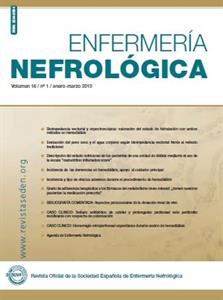Contenido del artículo principal
Resumen
Las demencias, aparecen cada día con más frecuencia en pacientes con tratamiento de hemodiálisis; la edad de entrada al tratamiento dialítico ha aumentado en los últimos años, influenciada por el aumento e la esperanza de vida. El deterioro en el estilo de vida del paciente afecta tanto a familiares como cuidadores, presentándose una situación compleja y difícil de manejar. En la actualidad, constituye un serio problema de salud con una repercusión social y económica a gran escala, por la pérdida de independencia del paciente y la carga física y psicológica que sufre la familia.
Objetivo: Conocer la incidencia de las demencias y su relación con la edad, sexo, nivel de estudios, patologías asociadas.
Material y método: Estudio descriptivo y transversal. Para conocer la incidencia de las demencias utilizamos el cuestionario: (short portable mental status questionarire Pfeiffer). Variables: sexo, edad, nivel de estudios, Convivencia, Hipertensión arterial, Diabetes.
Resultados: el 28% de los pacientes presentan demencia, 36% se encuentra entre 75-79 años, afectando considerablemente al sexo femenino. El 58% no han terminado los estudios primarios. Hipertensión arterial no es estadísticamente significativa, Diabetes Mellitus aparece en el 48% de los pacientes que presentan demencia.
Conclusión: La edad de los pacientes en hemodiálisis ha aumentado considerablemente, dando lugar a la aparición de las demencias, de ahí la necesidad de establecer las intervenciones de enfermería adecuadas para mejorar la calidad asistencial, ofrecer la información adecuada a familiares y cuidadores sobre las medidas a tener en cuenta en cada situación.
Palabras clave
Detalles del artículo
Derechos de autor 2013 Mª Ángeles Sánchez Lamolda, Mª Ángeles Malagón Rodríguez, Nemesia Alonso Hernández

Esta obra está bajo una licencia internacional Creative Commons Atribución-NoComercial 4.0.
Aviso de derechos de autor/a
© Los autores ceden de forma no exclusiva los derechos de explotación de los trabajos publicados y consiente en que su uso y distribución se realice con la Licencia Creative Commons Atribución - No comercial 4.0 Internacional (CC BY-NC 4.0). Puede consultar desde aquí la versión informativa y el texto legal de la licencia. Esta circunstancia ha de hacerse constar expresamente de esta forma cuando sea necesario.
Referencias
- Alma M. Bueno, Ana M. Calero, José M. Santonja. Estudio poblacional de prevalencia: proyecto demencia. Valencia. II Congreso Internacional de Neuropsicología en Internet. 2003.
- DSM-IV. Manual diagnostico y estadístico de los trastornos mentales. Barcelona: MASSON; 1995.
- American Psychiatric Association. DSM-IV. Manual diagnóstico y estadístico de los trastornos mentales. Masson S.A. Barcelona 1995.
- Félix Bermejo Pareja, Luis Aguera. Actualizaciones en Neurología, Neurociencias y Envejecimiento. 2003, (5): 275-276
- I. Frances, M. Barandiaran, T. Marcellán, L.Moreno. Estimulación psicognoscitiva en las demencias. Anales del servicio Sanitario de Navarra. Vol. 26,nº 3, septiembre-diciembre 2003, pags 339-480.
- C. Carnero- Pardo, M.T. Montoro-Ríos. Evaluación preliminar de un nuevo test de cribado de demen-cias. Rev. Neurol. 2004; 38(3): 201-209.
- Dueñas-Herrero, M. Onis-Vilches y colaboradores. Adaptación y validación al castellano del cuestionario de PFEIFFER (SPMSQ) para detectar la existencia de deterioro cognitivo en personas mayores de 65 años. Med CLIN (Barc) 2001; 117:129-34.
- Marcio Soto-Anari & Gabriela Cáceres-Luna. Funciones ejecutivas en adultos mayores alfabetizados y no alfabetizados. Revista de Neuropsicología nº 3 Diciembre 2012.9. Joanne McCloskey Dochterman Gloria M. Bulechek Clasificación de Intervenciones de enfermería (NIC) cuarta edición Elsevier España, S.A. Madrid 2005.
Referencias
Alma M. Bueno, Ana M. Calero, José M. Santonja. Estudio poblacional de prevalencia: proyecto demencia. Valencia. II Congreso Internacional de Neuropsicología en Internet. 2003.
DSM-IV. Manual diagnostico y estadístico de los trastornos mentales. Barcelona: MASSON; 1995.
American Psychiatric Association. DSM-IV. Manual diagnóstico y estadístico de los trastornos mentales. Masson S.A. Barcelona 1995.
Félix Bermejo Pareja, Luis Aguera. Actualizaciones en Neurología, Neurociencias y Envejecimiento. 2003, (5): 275-276
I. Frances, M. Barandiaran, T. Marcellán, L.Moreno. Estimulación psicognoscitiva en las demencias. Anales del servicio Sanitario de Navarra. Vol. 26,nº 3, septiembre-diciembre 2003, pags 339-480.
C. Carnero- Pardo, M.T. Montoro-Ríos. Evaluación preliminar de un nuevo test de cribado de demen-cias. Rev. Neurol. 2004; 38(3): 201-209.
Dueñas-Herrero, M. Onis-Vilches y colaboradores. Adaptación y validación al castellano del cuestionario de PFEIFFER (SPMSQ) para detectar la existencia de deterioro cognitivo en personas mayores de 65 años. Med CLIN (Barc) 2001; 117:129-34.
Marcio Soto-Anari & Gabriela Cáceres-Luna. Funciones ejecutivas en adultos mayores alfabetizados y no alfabetizados. Revista de Neuropsicología nº 3 Diciembre 2012.9. Joanne McCloskey Dochterman Gloria M. Bulechek Clasificación de Intervenciones de enfermería (NIC) cuarta edición Elsevier España, S.A. Madrid 2005.




